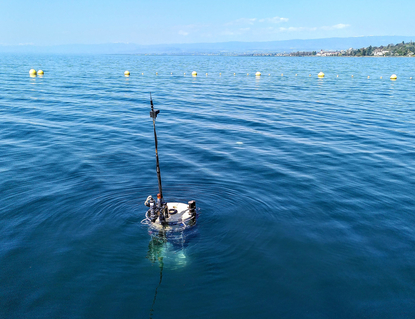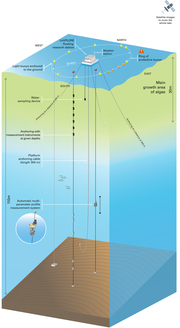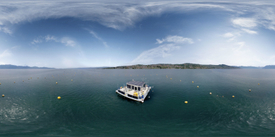LéXPLORE – the floating research station

Article from the Info Day Magazine 2022
A globally unique research facility has been floating on Lake Geneva since 2019. With automatic measuring sensors and multidisciplinary collaboration, it will significantly improve our understanding of lakes.
Lakes are sensitive and complex ecosystems that provide habitats for numerous species and supply us humans with the vital resource of drinking water. Although they have been studied for a long time, there are still puzzles that make it difficult to assess how lakes react to climate change, for example, or how they can be protected from adverse effects such as pesticides or nutrient inputs. For this reason, a globally unique research station for lake research has been floating on Lake Geneva since 2019. LéXPLORE. It is around 100 square metres in size and equipped with high-tech sensors that can continuously measure physical, chemical and biological parameters down to a depth of 110 metres. Thus, it also detects rapidly changing processes such as temperature fluctuations. Combined with other monitoring data, these measurements help to better understand long-term developments such as the accumulation of pollutants or the decline in phosphorus levels.
Sensors also work at night
Traditionally, lakes are explored by taking water samples from ships or with locally anchored measuring instruments. The samples are then prepared, taken to a laboratory and analysed there. Sampling and analysis are associated with a high technical and logistical effort, which has so far severely limited the frequency and scope of measurements. Consequently, continuous 24-hour measurements were almost unavailable, as it is rare for samples to be taken at night. However, many processes in lake ecosystems, such as primary production and the associated oxygen concentration, follow a circadian rhythm and can therefore only be adequately monitored by 24-hour measurements. The LéXPLORE research station offers new possibilities for this. It has sensors that take automated and continuous measurements and sends their data directly to the computers of the “Datalakes” data platform, where it is stored, processed and made available in real time on a public portal.
Observing blue-green algae by satellite
The LéXPLORE research station not only offers researchers an ideal infrastructure, but also facilitates collaboration between different disciplines, for example, in the validation of satellite data. Satellite data can be used, for example, to monitor phytoplankton such as blue-green algae in lakes. Blue-green algae can develop almost explosively within a few days and excrete toxic substances that endanger humans and animals. With conventional methods of investigation, it is scarcely possible to detect algal blooms at an early stage and follow their development. Researchers from LéXPLORE have therefore compared images of optical satellite data of Lake Geneva with data from sensors that automatically measure in the lake. Their preliminary findings show that satellite data can be used to detect blue-green algae blooms. In future, it could thus become easier to warn the population in good time about blue-green algae and the associated danger of toxins in lake water.
The LéXPLORE research station is operated by Eawag, the EPFL, the Universities of Lausanne and Geneva and the Alpine Research Centre for Trophic Networks and Limnic Ecosystems (CARRTEL) in Thonon-les-Bains (France). It offers 16 on-site workstations, is equipped with laboratories and is available to all interested water researchers. Currently, around 40 projects are underway that investigate physical, chemical or biological processes or further develop new technologies (see graphic top right).
The researchers of the station undertake to make their data freely available on the “Datalakes” data platform. Individual projects were presented at the Info Day, for example on environmental observation from space and on Kristin Schirmer’s research.
Created by Manuela di Giulio for the Info Day Magazine 2022




